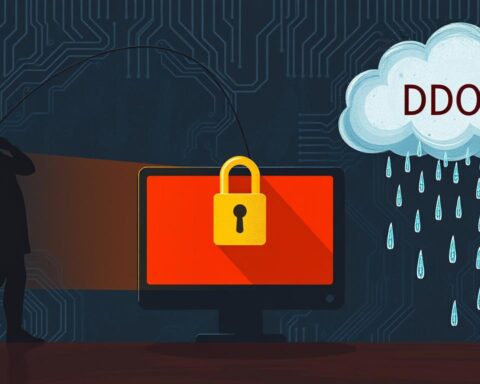In today’s world, digital threats are everywhere. A shocking fact is that cybercrime could cost the world $6 trillion by 2021. This is a huge jump from $3 trillion in 20151. This shows how vital cyber insurance is in our digital world.
Organizations face many cyber threats. It’s key to understand cyber insurance well.
The average cost of a U.S. data breach is about $9.48 million. Yet, cyber insurance in the U.S. costs only $1,589 a year for a $1 million liability limit2. This shows the financial benefits of cyber insurance. But, choosing the right policy is complex and needs careful thought.
We will look into cyber insurance’s role in managing risks. We’ll discuss its benefits and drawbacks. Our aim is to help you make smart choices for your cybersecurity. This way, you can avoid financial and reputation losses from cyber attacks.
Key Takeaways
- Cybercrime costs are skyrocketing, stressing the need for strong protection
- Cyber insurance can lessen financial risks from data breaches
- It’s important to understand policy details for good coverage
- Finding the right balance between insurance costs and possible losses is essential
- Cyber insurance is a vital part of managing risks
- Choosing a policy should match your organization’s needs
Understanding Cyber Insurance Fundamentals
Cyber insurance is a key protection in today’s digital world. It provides data breach protection and network security. As cyber threats grow, businesses must understand this vital protection.
Types of Cyber Insurance Coverage
Cyber insurance covers various financial damages. This includes costs from data breaches, phishing, and ransomware attacks3. The need for this coverage is increasing across all industries4.
Healthcare and financial sectors are at high risk. They need strong policies because they handle a lot of data4.
First-Party vs Third-Party Coverage
First-party coverage helps organizations deal with their own cyber-related losses. Third-party coverage helps with losses to others because of an organization’s cyber incident3. Knowing the difference is important, as 50% of cyber incidents involve third-party vendors4.
Key Policy Components
A good cyber insurance plan should have:
- Data breach response costs
- Business interruption coverage
- Cyber extortion protection
- Legal expense coverage
It’s important to note that some costs, like system upgrades, are often not covered4. Businesses must handle these costs on their own.
| Coverage Type | Protection Offered | Importance |
|---|---|---|
| First-Party | Direct organizational losses | Essential for all businesses |
| Third-Party | External entity losses | Critical for vendor relationships |
| Data Breach Response | Costs of managing a breach | Vital for damage control |
Knowing these basics is key to picking the right cyber insurance. With cyber-attacks up 42% in early 2022, the right coverage is more critical than ever3.
The Current State of the Cyber Insurance Market
The cyber insurance market is growing fast. Companies see it as key to fighting digital threats. With risks like data fraud and cyber attacks on the rise, they’re turning to insurance to manage risks5.
In 2022, the U.S. insurance industry made $1.22 trillion in net premiums. Property/casualty insurers got 53% of this, and life/annuity insurers got 47%6. This shows how big and important insurance, including cyber coverage, is today.
The cyber insurance sector is young but has huge growth chances. Big companies see it as key to protecting against cyber threats5. This is because of big breaches that have exposed millions of Americans’ personal info56.
Getting cyber insurance makes companies better at security. They have to check their systems, which helps them improve5. It’s like how business interruption insurance encourages companies to reduce risks5.
The insurance industry has its own cybersecurity challenges. It employs 2.9 million people in the U.S. and has 5,978 companies6. Keeping sensitive info safe is a big deal for them, as security experts say6.
“Cyber insurance is becoming a critical tool for businesses to transfer risk and protect against financial losses from cyber incidents.”
As the market grows, following rules will be more important. The Department of Homeland Security is working on this. They want to help the market grow by tackling new risks5.
| Risk Management Method | Description |
|---|---|
| Avoidance | Eliminating exposure to possible risks |
| Mitigation | Lowering the chance or impact of risks |
| Transfer | Passing risk to another party (e.g., insurance) |
| Acceptance | Knowing and getting ready for possible risks |
Cyber threats are changing, and insurance needs to keep up. The cyber insurance market’s growth is a big chance for insurers. It’s also a key way for companies to protect themselves in our digital world.
Cyber Insurance: Weighing the Benefits and Understanding the Risks
Cyber insurance is a financial safety net for businesses in the digital world. The global cyber insurance market was worth $7.06 billion in 2020. It’s expected to grow to $20.43 billion by 2027, with a 24% annual growth rate7. This growth shows how much businesses are now aware of cyber risks and need protection.
Primary Benefits of Coverage
Cyber insurance protects against cyber liability and ransomware attacks. It covers costs like data breach response, legal fees, and public relations expenses8. For healthcare, the average claim is $134,000, and for financial services, it’s $150,0008.
Common Risk Factors
Small and medium-sized businesses (SMBs) are often targeted by cybercriminals. They have fewer resources for security. From 2018 to 2022, SMBs made up 98% of cyber claims7. The global average cost of a data breach in 2023 was $4.45 million, showing the financial damage of cyber attacks7.
Cost-Benefit Analysis
Businesses must weigh the costs and benefits of cyber insurance. An SME with good security and under $25 million in revenue can get a policy for $1 million to $3 million for under $10,0007. This investment can protect against big losses.
| Industry | Average Claim Cost | Potential Benefits |
|---|---|---|
| Healthcare | $134,000 | Data breach coverage, regulatory compliance support |
| Financial Services | $150,000 | Ransomware protection, legal fee coverage |
Cyber insurance is valuable, but policies can have exclusions. For example, 49% of breaches in a study year were from lost laptops, which might not be covered9. Regular policy reviews and working with cyber security experts can ensure coverage meets business needs.
Evaluating Cyber Insurance Providers
Choosing the right cyber insurance provider is key for good coverage and support during cyber attacks. Let’s look at important factors to consider when picking an insurer.
Assessment Criteria
When checking out cyber insurance providers, look at their financial health, industry know-how, and how they treat customers. Seek out insurers with wide coverage, including third-party liability and incident response. The cyber insurance market is booming, expected to hit over $20 billion in the next four years10.
Market Leadership Indicators
Top cyber insurers lead the way. They often set high standards, like requiring strong security measures. This shows their dedication to managing risks10. Companies with specific cyber policies and those boosting security to meet insurer demands show they’re serious about risk management11.

Claims Handling History
Check how well the insurer handles claims. Good providers cover costs like breach investigations and extended credit monitoring10. With ransomware causing over $29.1 million in losses in 2020, a solid claims process is essential10.
Keep in mind, 83% of big security bosses say they have cyber insurance11. By carefully picking a provider, you can find one that fits your company’s needs and risk level.
Risk Assessment and Premium Determination
Cyber insurance providers use advanced methods to check how secure an organization is. They look at many factors and what security steps are already in place.
Insurance companies use both numbers and detailed info to understand cyber risks. They look at things like the type of business, how big it is, what data it has, and its security measures. In 2022, the FBI’s Internet Crime Complaint Center saw 800,944 complaints, leading to $10.3 billion in losses. This was a 49 percent jump from the year before12.
They ask 191 questions about an organization’s cybersecurity practices. This helps them figure out the chances and possible damage from cyber attacks12.
Recently, strong cybersecurity has become more important:
- 69 percent more cybercrime reports from 2019 to 202012
- 48 percent more phishing attacks in the first half of 202012
- 41 percent more ransomware attacks in 202212
These numbers show why good cyber insurance is key. Insurers keep improving how they check risks. They use new data sources like IoT and satellites to spot and study risks13.
Knowing how risk assessment works helps organizations improve their security. This not only gets them better insurance deals but also makes them more resilient against cyber threats.
Coverage Limitations and Exclusions
It’s key to know what cyber insurance can’t cover. These policies protect against data breaches but have limits. It’s vital to understand these restrictions.
Standard Policy Exclusions
Cyber insurance doesn’t cover acts of war, terrorism, or fraud by employees. It also excludes losses from stolen intellectual property1415. Businesses need to check these exclusions to see their risks.
Coverage Gaps
There are gaps in coverage that can put businesses at risk. Most policies only cover direct costs to the business, not losses to customers or others15. Small businesses and charities are often targeted because of weak security, making full coverage essential15.
Policy Sublimits
Sublimits can limit how much you get from a claim. Many policies have a waiting period of 8-12 hours before they start covering15. Policies also might have deductibles, copays, or other cost-sharing that affect your costs14.
To deal with these limits, businesses should strengthen their cybersecurity and check their policies often. Remember, 76% of companies hit by data breaches face impacts as bad as natural disasters or fires, showing the need for full coverage15.
Incident Response and Claims Process
When a cyber attack happens, quick action is key. Knowing how to handle incidents and claims helps businesses recover well. This part explains how to document cyber incidents, the response timeline, and how to file claims.
Documentation Requirements
Good documentation is essential for successful claims. Security firms, often targeted by cybercriminals, must record all incident details16. This includes:
- A detailed timeline of the attack
- The systems and data affected
- The steps taken to lessen damage
- An assessment of the financial impact
Response Timeline
The typical response to cyber incidents involves:
- Quickly detecting and containing the incident
- Telling the insurance provider within 24-48 hours
- Working with incident response services as the policy requires
- Keeping in touch with insurers during the fix
Claim Filing Procedures
To file a claim, follow these steps:
- Notify your insurer right away
- Give them all the incident details
- Work with the insurer’s investigation
- Submit a formal claim with all needed evidence
The claims process’s efficiency is key. It affects how fast a business can recover from a cyber attack16. Business interruption insurance can help cover lost income and extra costs from disruptions16.
Recent data shows crisis costs usually make up about 52% of total expenses in cyber claims. This includes costs for privacy lawyers, digital forensics, and public relations17. Also, 97% of businesses with cyber insurance that faced an attack said their insurance covered their losses well17.
| Aspect | Data |
|---|---|
| Average Ransomware Claim (Middle-Market) | $500,000 per event |
| Large Enterprise Ransomware Claims | Eight-figure loss range |
| Business Satisfaction with Cyber Insurance | 7.19 out of 10 |
With about 150 insurance companies writing cyber insurance, policies can differ a lot17. It’s important to know your policy well and work closely with your provider during the claims process.
Regulatory Compliance and Insurance Requirements
The world of cyber insurance is changing fast. This is because of more threats and rules. Businesses are facing more cyber risks, and insurance companies are updating their plans to meet these needs.
Now, cyber insurance policies often cover fines and penalties. This change shows how important following rules is in the digital world. Many policies have special rules for laws like GDPR and HIPAA18.
The global cyber insurance market is growing fast. It’s expected to hit $29.2 billion by 2027, with a 19.8% growth rate from 202219. This growth is because of the increasing costs of cybercrime, which could reach $10.5 trillion by 202520.
Companies with sensitive data face bigger cyber risks. They often need special insurance to cover fines and legal costs from data breaches19. The average cost of a data breach in 2022 was $4.35 million, showing the financial risks20.
Insurance companies are pushing for better cybersecurity. They suggest using Multi-Factor Authentication (MFA) and keeping software up to date. These steps can make a company’s security stronger and might lower insurance costs1819.
As cyber threats keep changing, businesses need to keep up with new rules and insurance choices. By matching their cybersecurity plans with both rules and insurance, companies can protect themselves in today’s digital world.
Best Practices for Policy Management
Managing your cyber insurance policy well is key to keeping your coverage strong. Regular checks and updates are vital to protect against new threats. Let’s look at some strategies to boost your cybersecurity and get the most from your insurance.
Regular Policy Reviews
Regularly checking your policy makes sure it matches today’s risks. Many companies find it hard to know what they really need for cybersecurity. A big problem is that 40% of companies think cyber attacks don’t hurt their profits, which might make them underestimate the value of insurance21.
This shows how important it is to do thorough, regular checks.
Coverage Updates
Cyber threats are always changing, so your insurance should too. Keep up with new risks and update your coverage with your provider. It’s interesting that 90% of companies with 100-5,000 employees have cyber insurance, but 40% are not sure if it covers ransom payments22.
This shows how important it is to talk clearly with your insurer and keep your policy up to date.
Risk Mitigation Strategies
Using strong ransomware protection and other security steps can really help your insurance. In fact, 99.6% of companies that improved their cyber defenses saw a positive change in their insurance22. This proactive step not only boosts security but can also get you better insurance terms.
| Policy Management Practice | Impact on Insurance | Benefit to Organization |
|---|---|---|
| Regular Policy Reviews | Ensures up-to-date coverage | Reduces possible coverage gaps |
| Coverage Updates | Adapts to new cyber threats | Improves overall protection |
| Risk Mitigation Strategies | Improves insurance position | Lowers premiums and increases coverage options |
By focusing on these best practices, organizations can better manage their cyber insurance policies. This strengthens their security posture. Remember, good policy management is more than just having coverage. It’s about making sure your insurance keeps up with cyber threats and your specific needs.
Conclusion
Cyber insurance is key in today’s risk management. It acts as a financial shield against cyber attacks. The Department of Commerce sees it as a way to boost cybersecurity by encouraging prevention.
Cyber attacks can cost a lot. Healthcare and financial services often face claims over $100,000. Ransomware can lead to losses over $200,0008. This shows the big financial risks businesses face, with data breaches costing about $4.24 million on average23.
Yet, many companies are not well-protected. Around 47% are looking into cyber insurance, but 33% feel they’re not covered enough23. This is worrying, as 60% of small businesses fail after a cyber attack23. To improve, businesses should think about combining cyber insurance with other risk management tools24.
Cyber threats are changing, and so must our defenses. Regular policy checks, risk assessments, and strong security are vital. With good cyber insurance and proactive security, businesses can stay safe in our digital world.
FAQ
What is cyber insurance?
What’s the difference between first-party and third-party cyber coverage?
How do insurers determine cyber insurance premiums?
Are acts of war covered under cyber insurance policies?
How does cyber insurance support regulatory compliance?
What should organizations consider when evaluating cyber insurance providers?
How often should cyber insurance policies be reviewed and updated?
What is a policy sublimit in cyber insurance?
FAQ
What is cyber insurance?
Cyber insurance helps protect companies from financial losses due to cyber attacks. This includes data breaches and ransomware attacks. It covers both direct losses to the company and liability claims from others.
What’s the difference between first-party and third-party cyber coverage?
First-party coverage helps the company itself after a cyber attack. It covers costs like data recovery and business interruption. Third-party coverage protects against claims from others, like customers whose data was stolen.
How do insurers determine cyber insurance premiums?
Insurers look at many factors to set premiums. These include the company’s industry, size, and data assets. They also consider the company’s cybersecurity measures and past cyber incidents.
Are acts of war covered under cyber insurance policies?
Most cyber insurance policies don’t cover acts of war. But, what counts as “war” in cyber attacks can be tricky. Some insurers offer special coverage for certain cyber attacks.
How does cyber insurance support regulatory compliance?
Cyber insurance helps with regulatory costs after a breach. It also offers resources to keep up with regulations. This helps companies stay compliant.
What should organizations consider when evaluating cyber insurance providers?
Look at the insurer’s financial health and expertise. Check their claims history and coverage options. Also, see if they offer extra services like cybersecurity training.
How often should cyber insurance policies be reviewed and updated?
Review policies yearly, or more often if your risk changes. This keeps coverage up to date with new threats and business changes.
What is a policy sublimit in cyber insurance?
A sublimit is a cap on a specific loss type within the policy limit. For example, a million limit might have a
FAQ
What is cyber insurance?
Cyber insurance helps protect companies from financial losses due to cyber attacks. This includes data breaches and ransomware attacks. It covers both direct losses to the company and liability claims from others.
What’s the difference between first-party and third-party cyber coverage?
First-party coverage helps the company itself after a cyber attack. It covers costs like data recovery and business interruption. Third-party coverage protects against claims from others, like customers whose data was stolen.
How do insurers determine cyber insurance premiums?
Insurers look at many factors to set premiums. These include the company’s industry, size, and data assets. They also consider the company’s cybersecurity measures and past cyber incidents.
Are acts of war covered under cyber insurance policies?
Most cyber insurance policies don’t cover acts of war. But, what counts as “war” in cyber attacks can be tricky. Some insurers offer special coverage for certain cyber attacks.
How does cyber insurance support regulatory compliance?
Cyber insurance helps with regulatory costs after a breach. It also offers resources to keep up with regulations. This helps companies stay compliant.
What should organizations consider when evaluating cyber insurance providers?
Look at the insurer’s financial health and expertise. Check their claims history and coverage options. Also, see if they offer extra services like cybersecurity training.
How often should cyber insurance policies be reviewed and updated?
Review policies yearly, or more often if your risk changes. This keeps coverage up to date with new threats and business changes.
What is a policy sublimit in cyber insurance?
A sublimit is a cap on a specific loss type within the policy limit. For example, a $5 million limit might have a $1 million cap for ransomware. Knowing these limits is key for claims.
How does cyber insurance contribute to an organization’s overall cybersecurity strategy?
Cyber insurance is part of a strong cybersecurity plan. It encourages good security practices and offers access to experts. This helps make the company more resilient against cyber threats.
What steps should an organization take immediately after a cyber incident to ensure a smooth claims process?
Notify your insurer right away and document the incident. Use approved response providers and follow the insurer’s advice. Good documentation and quick communication are key for a smooth claims process.
million cap for ransomware. Knowing these limits is key for claims.
How does cyber insurance contribute to an organization’s overall cybersecurity strategy?
Cyber insurance is part of a strong cybersecurity plan. It encourages good security practices and offers access to experts. This helps make the company more resilient against cyber threats.
What steps should an organization take immediately after a cyber incident to ensure a smooth claims process?
Notify your insurer right away and document the incident. Use approved response providers and follow the insurer’s advice. Good documentation and quick communication are key for a smooth claims process.
How does cyber insurance contribute to an organization’s overall cybersecurity strategy?
What steps should an organization take immediately after a cyber incident to ensure a smooth claims process?
Source Links
- PDF – https://www.divurgent.com/wp-content/uploads/2018/07/Mitigating-Cybersecurity-Risk_fv.pdf
- The Complex World of Cyber Insurance – https://complexdiscovery.com/the-complex-world-of-cyber-insurance/
- Understanding the basics of cyber insurance – https://www.pacificprime.hk/blog/understanding-the-basics-of-cyber-insurance/
- What Is Cyber Insurance, and Do You Need It? – https://www.mcafee.com/learn/what-is-cyber-insurance-and-do-you-need-it/
- – THE ROLE OF CYBER INSURANCE IN RISK MANAGEMENT – https://www.govinfo.gov/content/pkg/CHRG-114hhrg22625/html/CHRG-114hhrg22625.htm
- How cybersecurity is crucial to the insurance industry – https://cybersecurityguide.org/industries/insurance/
- Cyber Insurance Essentials: Costs & Market Insights – https://www.koop.ai/blog/do-you-need-cyber-coverage-heres-a-checklist
- Is Cyber Insurance Worth It? Navigating cyber threats. – https://eandyagency.com/blog/is-cyber-insurance-worth-it/
- Cyber Insurance: The False Sense of Security – https://www.linkedin.com/pulse/cyber-insurance-false-sense-security-f12-net-wlsde
- The Role of Security Frameworks in Determining Cyber Insurance Risks | Apptega – https://www.apptega.com/blog/the-role-of-security-frameworks-in-determining-cyber-insurance-risks
- Who should be in the room when purchasing cyber insurance? – https://www.cybersecuritydive.com/news/buying-cyber-insurance-ciso/732506/
- Cyber Insurance Risk Assessment Guide – Christo IT – https://www.christoit.com/cyber-insurance-risk-assessment-guide/
- A Guide to Risk Assessment in the Insurance Industry – https://insurtechdigital.com/articles/what-is-risk-assessment
- The value of cyber insurance for health care providers – https://rsmus.com/insights/industries/health-care/the-value-of-cyber-insurance-for-health-care-providers.html
- Everything You Need to Know About Cyber Insurance – https://sprinto.com/blog/cybersecurity-insurance/
- Cyber Insurance for Security Firms: Safeguarding Against Digital Threats – ALKEME – https://alkemeins.com/cyber-insurance-for-security-firms-safeguarding-against-digital-threats/
- Does Cyber Insurance Pay Out? – https://woodruffsawyer.com/insights/cyber-insurance-pay-out
- Emerging Cyber Insurance Requirements for Businesses – https://www.secondstartechnologies.com/blog/emerging-cyber-insurance-requirements-for-businesses
- Is Cyber Liability Insurance Worth the Cost? Explore the Pros and Cons – https://www.bitlyft.com/resources/is-cyber-liability-insurance-worth-the-cost-explore-the-pros-and-cons
- Cyber Insurance: The Growing Threat of Cyber Attacks and Why Your Business Needs It – Tower Street Insurance – https://www.towerstreetinsurance.com/blog/the-growing-threats-of-cyber-attacks/
- Governance and Insurance – https://www.american.edu/kogod/research/cybergov/articles/governance-insurance-solving-cyber-risk.cfm
- Is Cyber Insurance Worth It? Weighing the Pros and Cons – https://synchroworks.net/is-cyber-insurance-worth-it-pros-and-cons/
- Advantages and Limitations of cyber risk or security insurance – https://securenow.in/insuropedia/what-are-the-advantages-and-limitations-of-cyber-risk-or-security-insurance/
- What are Cyber Insurance and Cyber Warranties? – https://calitgroup.com/what-is-cyber-insurance-and-how-does-it-differ-from-a-cyber-warranty/










